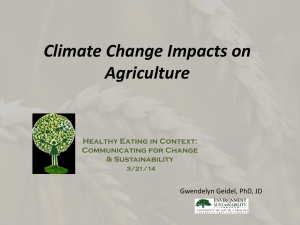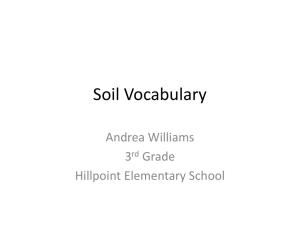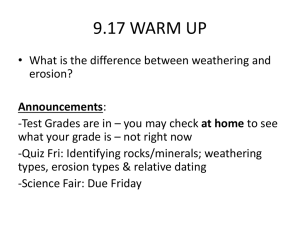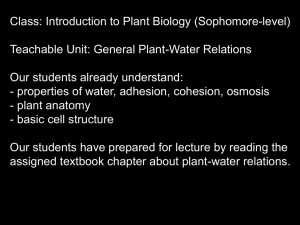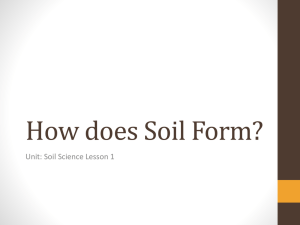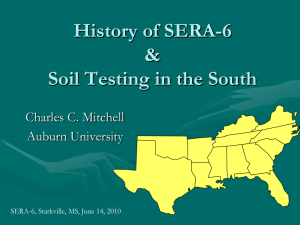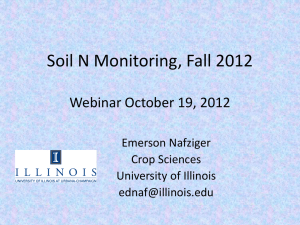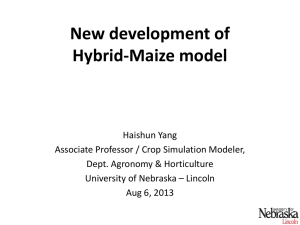Soil Erosion Estimation
advertisement
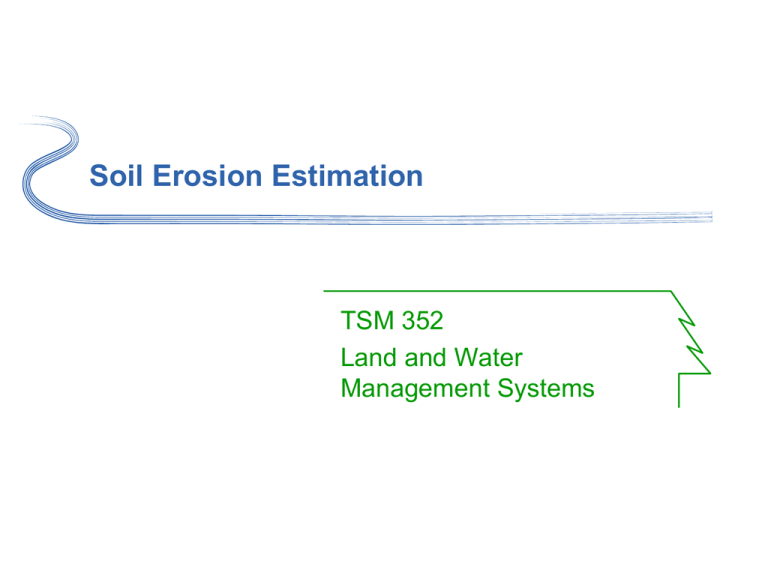
Soil Erosion Estimation TSM 352 Land and Water Management Systems Soil Erosion Predicting Soil Loss Plot scale models (Net erosion, only water erosion) o o o Small watershed scale model (Net erosion) o USLE – “Universal” Soil Loss Equation (AH 537, 1978) MUSLE – Modified USLE (Williams, 1981) RUSLE – Revised USLE (AH 703, 1996) WEPP – water erosion prediction project More process-oriented, including parameters like biomass, plant height, canopy cover, temporal variations,… Medium watershed models (Gross erosion) o Radioisotope tracer models - 137Cs, 210Pb, 7Be,… Soil Erosion USLE Describes erosion as a function of: o o o o o o Rainfall energy and intensity Soil properties : erodibility Topography: slope length and steepness Soil cover Conservation practices Based on 10,000 plot years of data Soil Erosion USLE A = RK(LS)(C).(P) A = Estimated soil loss in tons/acre/yr R = Rainfall erosivity factor, expressed by an average erosion index K = Soil erodibility factor for specific soil horizon LS = Topographic factor, L = Slope length factor: ratio of loss from a given slope length to soil loss from a 72.6 ft length under the same conditions S = Slope steepness factor: ratio of loss from a 9% under the same conditions C = Cover management factor: soil loss relative to that from a continuously fallow area P = Support practice factor: soil loss relative to straight row farming up- and downhill Soil Erosion Soil Erosion The USLE Equation: R Factor Rainfall and runoff erosivity factor (R) Varies with: o amount of runoff o individual storm precipitation patterns Characterizes: o The kinetic energy raindrop impact (E) o Maximum 30-min storm intensity (I) An annual erosivity index for a location is determined by: Summing up E x I for all storms (n) The average annual rainfall and runoff erosivity index (R) = (sum of E x I) / n Soil Erosion Soil Erosion Soil Erosion Soil Erodibility Factor (K) Susceptibility of soil to erosion soil loss measured on a series of soils on a unit plot with “worst case” conditions 72.6 ft long 9% slope continuously tilled and fallow assumed constant all year Result of unit plot experiments Nomograph based on: soil texture / structure / permeability Most erodible soils with high silt contents Least erodible soils with high organic matter / strong subsoil structure / high permeabilities Soil Erosion Soil Erosion Soil Erodibility Factor (K) Equation to calculate K K = [2.1x10-4 (12 – OM) M1.14 + 3.25(S – 2) + 2.5(P – 3)] / 100 o K = Soil erodibility in tons/ac/unit rainfall index o OM = Percent organic matter o M = (%MS + %VFS)(100 - %CL) o MS = percent silt (0.002 – 0.05 mm) o VFS = percent of very fine sand (0.05 – 0.1 mm) o CL = percent clay (< 0.002 mm) o S = Structure index (very fine granular = 1; fine granular = 2; medium or coarse granular = 3; blocky, platy, or massive = 4) o P = Permeability index (rapid = 1; moderate to rapid = 2; moderate = 3; slow to moderate = 4; slow = 5; very slow = 6) Soil Erosion Topographic Factor (LS) Adjusts erosion rates for: o greater erosion on longer / steeper slopes o o less erosion on shorter / flatter slopes when compared to the the USLE standard of: o 9% slope o 72.6 length Slope length measured from: o top of ridge to the outlet channel o top of ridge to where deposition begins Soil Erosion Topographic Factor (LS) Soil Erosion Topographic Factor - LS Factor Soil Erosion Cover Management Factor (C) C = integration of several factors vegetation cover crop rotations length of growing season land management (tillage practices) Conventional tillage leaves the surface bare therefore susceptible to erosion Conservation tillage leaves residue on surface protects the soil from rainfall impact : reduces sheet and rill erosion residue management soil surface binding of plant roots Soil Erosion Types of Tillage T i l l a g e : the mechanical modification of soil structure Classified by amount of residue left Conventional (CT): <15% Conservation (CM): >30% No-till (NT) Alternating (AT) University of Wisconsin, 2012. Soil Erosion Cover Management Factor For forest, rangeland and other non-agricultural lands C factors based on: density of vegetation vegetative residue on the soil surface For disturbed bare soil C = 1.0 Soil Erosion Soil Erosion Cover Management Factor No-till planting into corn residue Conservation (mulch) tillage using a chisel plow No-till soybeans growing in wheat stubble Soil Erosion Soil Erosion Support Practice Factor (P) P = Effect of erosion control practices Practices besides vegetation management Practices characterized by P are: o strip cropping o contouring o terraces P varies greatly with slope gradient For many applications, no erosion control practices are used 1.0 No experimental data for forests and rangelands Soil Erosion Soil Erosion Support Practice (P) Factor Contouring Terrace/Diversion, Grassed waterway Strip systems Soil Erosion Example Determine the average annual soil loss for the following conditions: location is Champaign, Illinois; soil is Drummer silt clay loam (“the official state soil of Illinois”); l = 300-ft; s = 5%; spring corn-soybean rotation with conservation tillage; and the field has contoured strip cropping conservation practice. Soil Erosion Wind erosion Important especially in arid regions Dependent on o o o o Wind speed and exposure Soil particle- and aggregate sizes Surface roughness Tillage Surface roughness creates turbulence in the surface-near air layer → Under pressure sucks particles in the air Form of movement: < 0.1 mm → Suspension (“dust storm”) < 1 mm → Saltation (“jumping”) > 1mm → Creep (“rolling”) Soil Erosion Questions?
